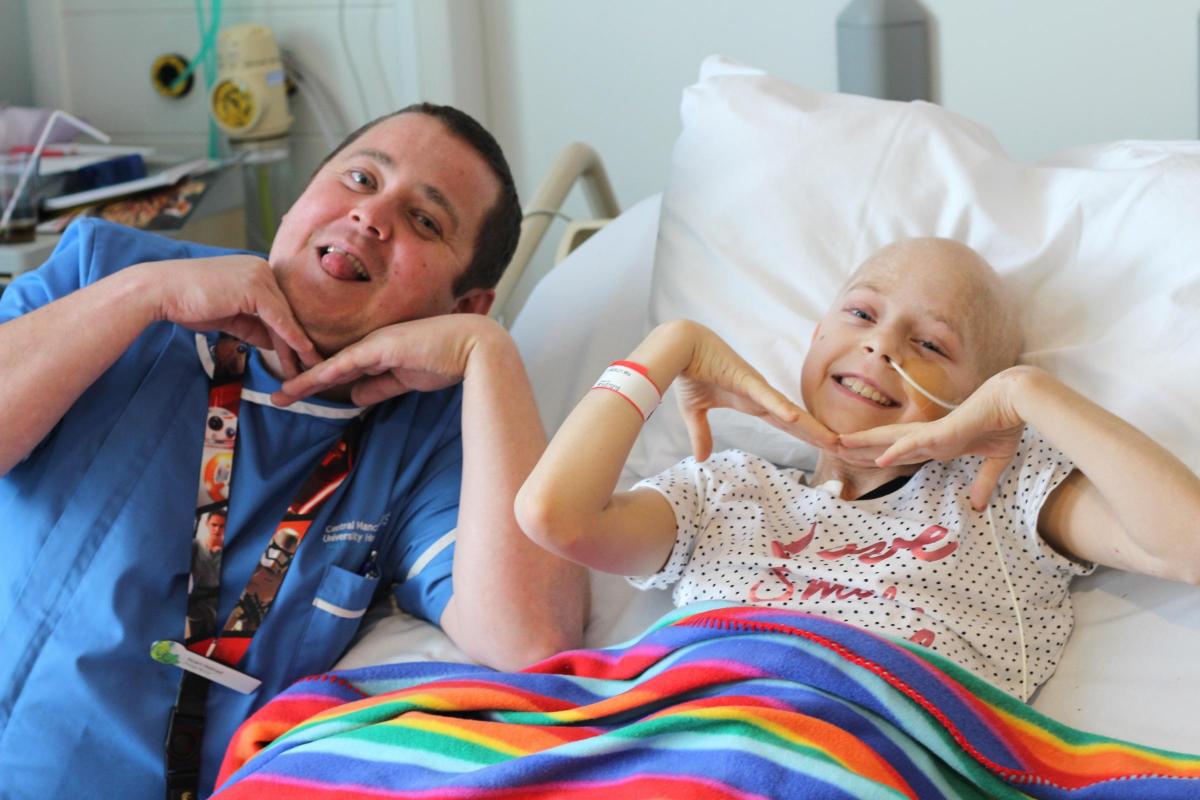Therapeutic communication is defined as the face-to-face process of interacting that focuses on advancing the physical and emotional well-being of a patient. For people outside of the medical profession, a hospital or doctor’s office can be intimidating place. The job of making a patient feel comforted and cared for often falls on the shoulders of the nurses. To best meet the needs of a patient, nurses must learn the principles and techniques of therapeutic communication, which is defined as communication strategies that support a patient’s feeling of well-being.
This term is easy to recall if you remember that something that is therapeutic is done to help a person cope with a situation and ultimately feel happier and more relaxed. The goals of therapeutic communication are to help a patient feel cared for and understood and establish a relationship in which the patient feels free to express any concerns. In this lesson, we’ll explore the different types and principles of therapeutic communication.
A nurse must be aware of his or her own non-verbal, or non-spoken, communication style. For example, if a nurse does not make eye contact with a patient who is describing a symptom or leans on a desk with her arms crossed, the patient may feel that the nurse is not interested in what they have to say. In contrast, a comforting touch on the arm from a nurse who is leaning toward the patient and making eye contact may help a patient feel like her concerns are being heard.
A nurse must also be able to pick up on non-verbal cues from the patient. A patient that appears to be tense, will not make eye contact, or who paces on the floor may have a concern or comment they are afraid to share. Observations of these non-verbal cues can be used to strengthen verbal or spoken, communication with a patient. With effective verbal communication a patient’s thoughts, feelings, beliefs, values, and perceptions can be conveyed. Nurses use therapeutic communication techniques to provide support and information to patients.
The 17 Therapeutic Communication Techniques
| TECHNIQUE | REASON TO USE | EXAMPLE |
| Affirm desired behaviors | Let your patient know that you’re aware of her efforts. This recognition acknowledgment is not framed as a compliment because a compliment for doing a basic task (like going to the bathroom by herself) can be perceived as condescending. | “I see you’re wearing the blouse your daughter brought yesterday.” |
| Ask for clarification | You’re not confident you understand your patient correctly due to certain ambiguous words, gestures, or body language. | “I’m not sure I got that. What did you mean by ‘everything is different now?’” |
| Ask open-ended questions | Helps you capture your patient’s thoughts and perceptions while also assessing his attitude, awareness, and thinking abilities. | “Tell me more about that.”
“How do you cope with that?” |
| Confront | You’ve established trust with your patient, and now you observe him saying or doing something inconsistent with an attitude, belief, or behavior he expressed earlier. Gently help him see the contradiction so you can help him align what he’s doing with the results he wants. | “Mr. Jones, you said you wanted to get back to your family as fast as possible, but you’ve been in bed all morning. Will you be ready to walk the hallway in the next half hour?” |
| Encourage formulation of an action plan | Your patient needs to break a bad habit or create a good habit. | “What are some steps you think you could take to help you limit the number of donuts you eat?” |
| Focus | Your patient is jumping from topic to topic without closure on anything. You need her to focus on one key area so you can capture critical details and so she isn’t overwhelmed by everything at once. | “You’ve brought up several good points. Let’s get back to what you said about sometimes forgetting if you took your medicine.” |
| Give information | Builds trust, reduces patient anxiety, and improves patient cooperation and safety because she understands what’s happening and why it’s happening and is therefore more likely to comply. | “After the surgery, you’ll have a drainage tube in your neck. You’ll need to change the surrounding bandage every 6 hours, then come back in three days to have it removed.” |
| Make broad opening remarks | Gives your patient the freedom to talk about what she wants to talk about. She has some control over circumstances and is not just a problem to be fixed. | “What’s on your mind today?”
“Where should we start?” |
| Offer your time and presence | Builds trust by demonstrating you care about and are interested in your patient. | “Is it ok if I sit with you until patient transport arrives?” |
| Place events in sequence | You need to understand what may have caused specific symptoms, and your patient should become aware of connections between his actions and his symptoms. | “Did you experience the light-headedness before or after you got up to leave the theater?” |
| Reflect | Your patient asks for advice, and you show respect for her judgment and encourage self-accountability by asking the question right back. | Patient: “Do you think I should tell my family physician?”
You: “Do you think you should?” |
| Restate / paraphrase | Assures your patient you heard and understood what he said. | Patient: “This food tastes like cardboard.”
You: “Not enough flavor for you?” |
| Share thoughts and observations | Shows your patient you are paying attention and encourage her to share more information. | “That must have been unpleasant.”
“You seem more tired today.” |
| Suggest comparisons | You need to convert a patient’s vague or abstract experience into something understandable. | “Does it feel like pins and needles pressing against your fingertips, or more like a pencil eraser?” |
| Summarize | You or your patient provided a lot of information. You need to confirm a shared understanding and bring closure to the discussion so you can document accurately. | “Ok, so we agreed you’ll press the call button next time you either feel that pain in your arm or feel like it’s more difficult to breathe.” |
| Use active listening | Builds trust by showing your patient that what she’s saying is important to you. She knows you are paying attention and feels like it’s safe to keep going. It also contributes to mental and emotional healing. | Make and hold eye contact.
Turn to face your patient. Nod in agreement. Don’t multitask. “Ok, I’m with you.” “Oh my.” |
| Use silence | Your patient needs time to collect and organize his thoughts and decide what to say next. | Retain eye contact.
Continue to face your patient so he knows you’re ready for him to continue. Allow your patient to speak next. |
In some interactions with patients, clinicians are simply being friendly. But in many interactions, clinicians are trying to achieve a clinical objective. Therapeutic communication techniques play a leading role in reaching the clinical objective.
To get maximum effectiveness from therapeutic communication techniques, clinicians should follow three steps:
- Catch cues from the patient. Is he calm and confident? Anxious and agitated? Eager and enthusiastic? Confused or clear-headed? Frustrated?
- Choose a technique that will likely support a positive discussion under the current circumstances.
- Fortify your words with intentional body language:
-
- Make and keep eye contact
- Sit if necessary, so your eyes are close to the same height as your patient’s eyes
- Square your shoulders toward your patient
- Focus all your attention on the patient (no multitasking)
- Speak in a conversational speed and tone
- Avoid postures, gestures, and facial expressions that suggest apathy, impatience, or judgment
When a clinician is skillful with therapeutic communications, they can develop a therapeutic relationship with their patient. Through that relationship, the clinician becomes more effective at recognizing and influencing meaningful changes in the patient’s physical, mental, and emotional state.
And remember, therapeutic communications are not restricted to face-to-face encounters. Technology brings more opportunities to use therapeutic communication techniques.
We’ve been using phones and email for years. More recent developments allow clinicians and patients to connect via secure texting and video conferencing. These technologies are especially helpful for patients with chronic conditions that require routine monitoring, and also for post-op patients who need follow-up care. Clinicians can build and strengthen their relationships by using these technologies to apply their therapeutic communication skills — even when patients have left the hospital or clinic.
Conclusions
According to the American Psychiatric Nurses Association, therapeutic communications are marked by “an attitude of respect, dignity, and empowerment.”
Sure, it’s a challenge. Nurses and therapists are asked to be always “on” and ready to pour their best mental and emotional energy into their communications while simultaneously offering their best clinical knowledge and skills.
But the rewards are massive. When nurses and therapists take their valuable clinical training and skills, add targeted therapeutic communication techniques, and take advantage of new ways to bring patients into the conversation, then we and the people we care about receive better care with fewer missteps, and our healing is faster and more complete. SEE: NANDA: How to Write a Nursing Diagnosis






